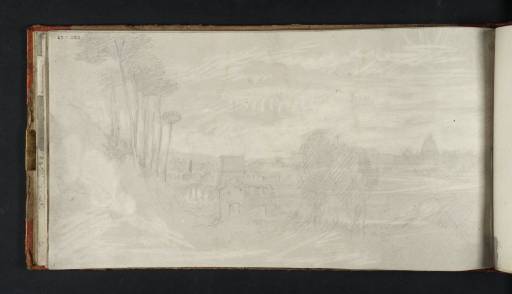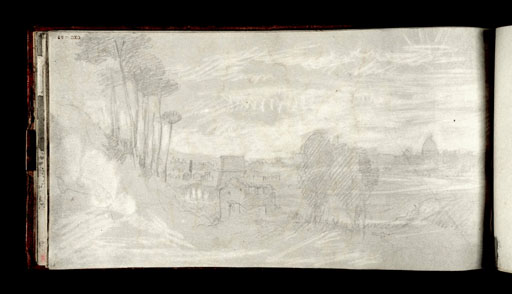Joseph Mallord William Turner Distant View of Rome from the Ponte Molle 1819
Image 1 of 2
Joseph Mallord William Turner,
Distant View of Rome from the Ponte Molle
1819
Joseph Mallord William Turner 1775–1851
Folio 47 Recto:
Distant View of Rome from the Ponte Molle 1819
D16467
Turner Bequest CXC 52
Turner Bequest CXC 52
Pencil and grey watercolour wash on white wove paper, 130 x 255 mm
Inscribed by an unknown hand in pencil ‘52’ bottom left
Stamped in black ‘CXC 52’ top left, inverted
Stamped in black ‘CXC 52’ top left, inverted
Accepted by the nation as part of the Turner Bequest 1856
References
1909
A.J. Finberg, A Complete Inventory of the Drawings of the Turner Bequest, London 1909, vol.I, p.566, as ‘Ponte Molle, with St. Peter’s in distance on the right.’.
By the nineteenth century, exploration of the city’s environs had become as much part of the Roman experience as its architecture and monuments. Turner made a large number of studies of the landscape north of Rome and many of the views within this sketchbook appear to relate to a single perambulation from Sant’Agnese fuori le mura to Ponte Sant’Angelo, by way of the ancient Ponte Molle, also known as the Ponte Milvio (for further information see the sketchbook introduction). The subject of this sketch is the view looking south from the Ponte Molle towards the distant skyline of the city, including, on the far right, the silhouette of St Peter’s. The arches of the Ponte Molle itself can be seen left of centre with the River Tiber sweeping in a large curve downstream to the right. Like many drawings within this sketchbook, the composition has been executed over a washed grey background. Turner has created areas of pale highlights by lifting or rubbing through to the white paper beneath, principally to delineate the reflection of light on the surface of the water and cloud formations in the sky. For other sketches of the Ponte Molle and the Tiber see folio 60 (D16485; Turner Bequest CXC 68).
Turner’s forays into the Campagna followed a long artistic tradition established during the seventeenth century by Claude Lorrain (circa 1600–82) and Nicolas Poussin (1594–1665). The two French masters had famously made a number of sketching trips along the banks of the Tiber north of the city; indeed the countryside between the Porta del Popolo and the Ponte Molle had popularly become known as the ‘Promenade de Poussin’.1 Turner was probably particularly inspired by the work of Claude Lorrain, and his eighteenth-century successor, the Welsh landscape artist, Richard Wilson (1714–1782). This sketch for example is similar in style and composition to a view by Wilson, Rome viewed from the Ponte Milvio by moonlight,2 one of a series of drawings related to the painting, Rome and the Ponte Molle 1754 (National Museum of Wales, Cardiff).3
Nicola Moorby
June 2009
See Richard Verdi, ‘Poussin’s Life in Nineteenth-Century Pictures’, Burlington Magazine, vol.111, no.801, December 1969, p.742; and Peter Galassi, Corot in Italy: Open-Air Painting and the Classical-Landscape Tradition, New Haven and London 1991, pp.162–3.
See Raymond Keaveney, Views of Rome from the Thomas Ashby Collection in the Vatican Library, exhibition catalogue, Smithsonian Institution, Washington 1988, no.61, pp.228–9, reproduced.
How to cite
Nicola Moorby, ‘Distant View of Rome from the Ponte Molle 1819 by Joseph Mallord William Turner’, catalogue entry, June 2009, in David Blayney Brown (ed.), J.M.W. Turner: Sketchbooks, Drawings and Watercolours, Tate Research Publication, December 2012, https://www


